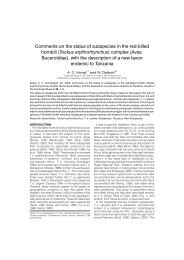EAZA Hornbill Management and Husbandry Guidelines
EAZA Hornbill Management and Husbandry Guidelines
EAZA Hornbill Management and Husbandry Guidelines
Create successful ePaper yourself
Turn your PDF publications into a flip-book with our unique Google optimized e-Paper software.
6.3.7 Inspection door <strong>and</strong> observation devices<br />
While the editors of these guidelines believe that breeding hornbills should be left alone<br />
as much as possible, there are certainly times when nest inspections or some form of<br />
intervention are desirable. It is highly recommended that an inspection door be fashioned<br />
at the backside of the nest box so that the inspection door can be opened to clean the nest,<br />
to remove eggs or young <strong>and</strong> to observe the female <strong>and</strong> her brood as appropriate. The<br />
door should be positioned at the height of the nest entrance, assuming that the entrance is<br />
not too high (see section 6.3.3: Dimensions of the nest entrance). The door should be<br />
fairly large (approximately 15 cm X 20 cm) so that even older chicks can be removed if<br />
necessary. The door should shut perfectly to avoid droughts, incoming light <strong>and</strong> opening<br />
by the female. Cuts to make the door can be angled inward to ensure that light will not<br />
come through the opening. Females may pound on the door <strong>and</strong> unless very well<br />
fastened, the door may open (e.g. Meyers, in press). For this reason Khin et al. (1997)<br />
recommended using a sliding door.<br />
Some hornbill managers (e.g. at Audubon Park Zoo <strong>and</strong> San Diego Zoo) that are quite<br />
successful with hornbills do routinely check hornbill nests (M. Mace <strong>and</strong> M. Meyers,<br />
pers. comms.). Nests at Audubon Park Zoo are checked every couple of days until egg<br />
laying is completed <strong>and</strong> then less frequently but regularly once hatching is expected. Nest<br />
inspections are made once or twice a week once chicks have hatched. One person<br />
distracts the female with a stick at the nest entrance while another person looks through<br />
the inspection door. The inspection door entrance is shrouded with a blanket, <strong>and</strong> a<br />
flashlight used to spot the eggs (M. Meyers, pers. comm).<br />
Presence of chick(s) inside the nest box can be observed with an investigation tube with a<br />
45° angle (Mace, pers. comm.), as described below in Figure 5, or by holding a<br />
stethoscope to the wall to hear chick sounds (Euing, 1995). A microphone mounted in the<br />
nest out of reach from the hornbills can enable hornbill managers <strong>and</strong> possibly visitors to<br />
monitor vocalizations <strong>and</strong> other sounds made within the nest. The speakers should be a<br />
good distance from the male so that he does not become confused.<br />
A video surveillance system provides a non-invasive monitoring method that yields much<br />
information. If nest images are also viewable by visitors, the system also provides a<br />
wonderful educational tool. Lieras (1983) provided a description of the video<br />
arrangement used to monitor a Luzon tarictic hornbill Penelopides manillae nest at San<br />
Diego Zoo <strong>and</strong> of observations made. Smith (2002) found monitoring equipment<br />
surprising inexpensive: the entire surveillance system to monitor a pair of Von der<br />
Decken’s hornbills Tockus deckeni at Oklahoma City Zoo, including two cameras, a<br />
monitor <strong>and</strong> all the necessary cables was US$ 90. See Section 6.3.8: Camera monitoring<br />
of nests for a description of video monitoring experiences at Chester Zoo.<br />
52




